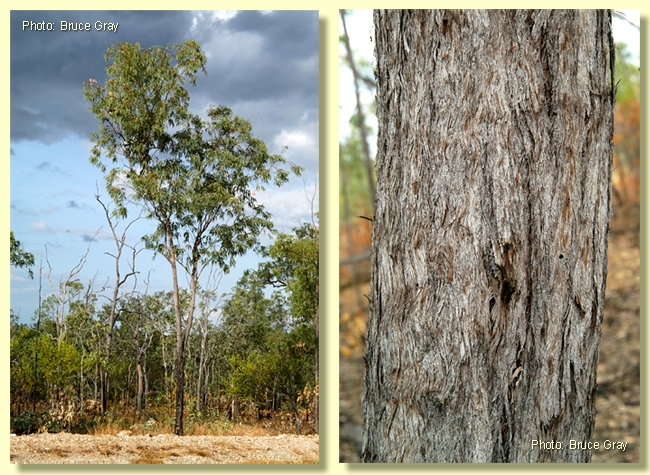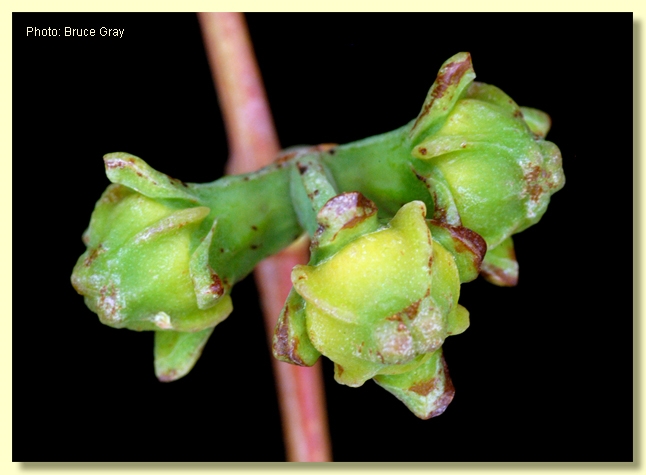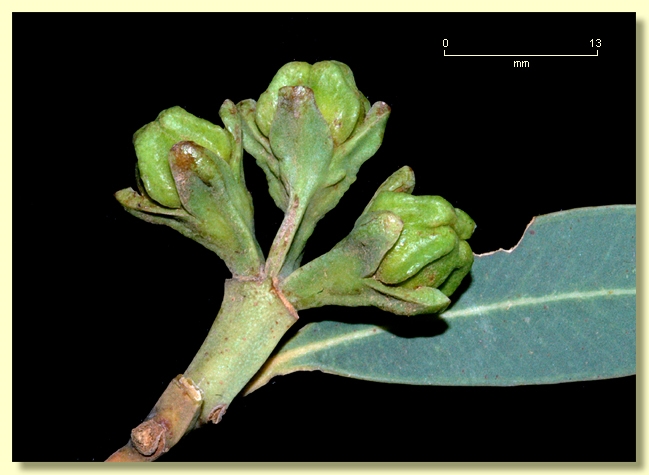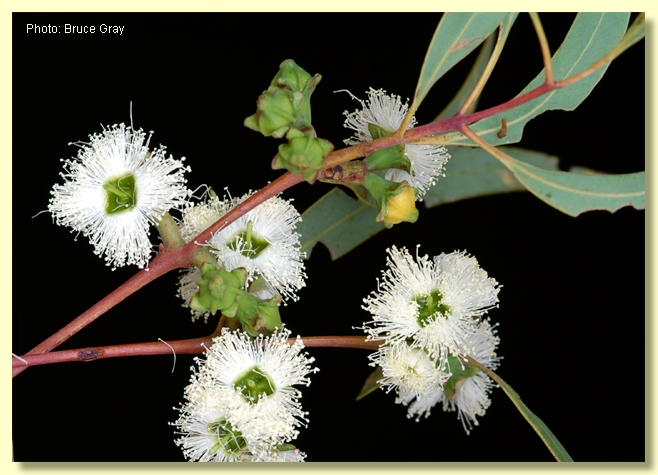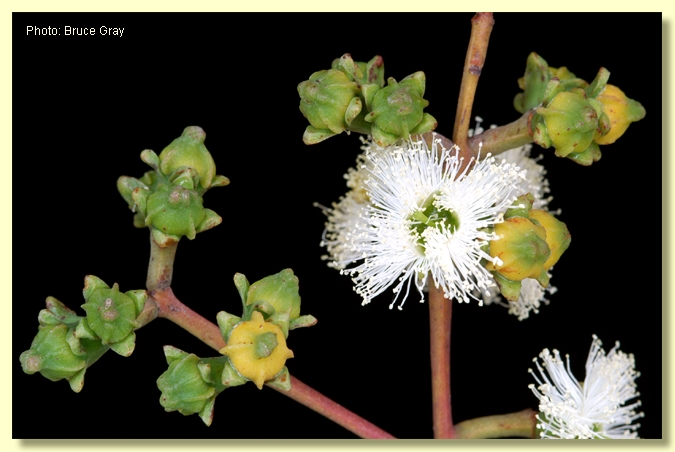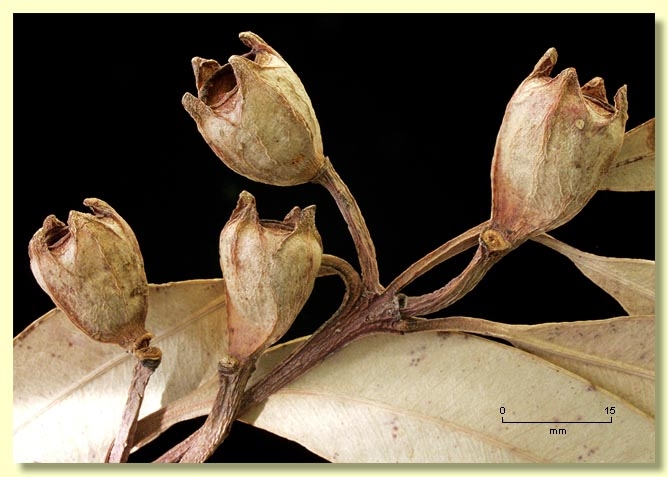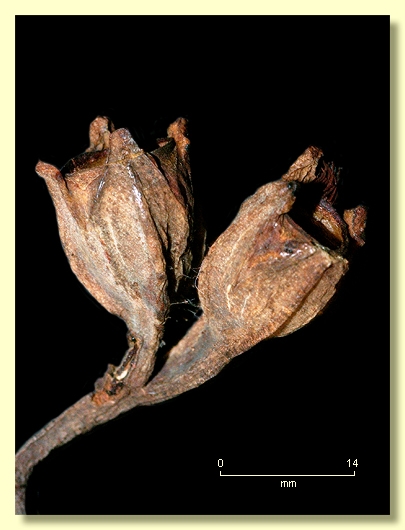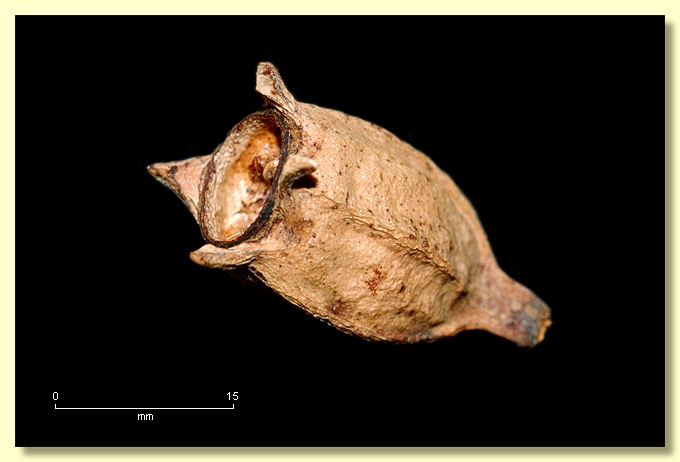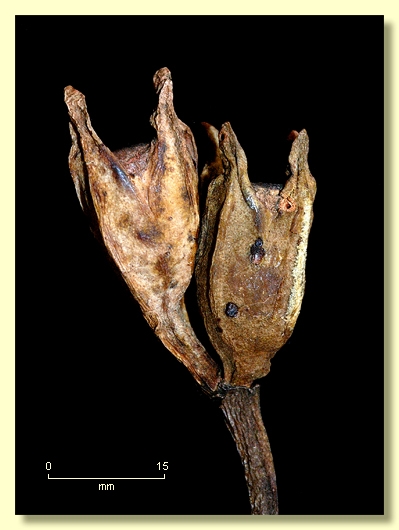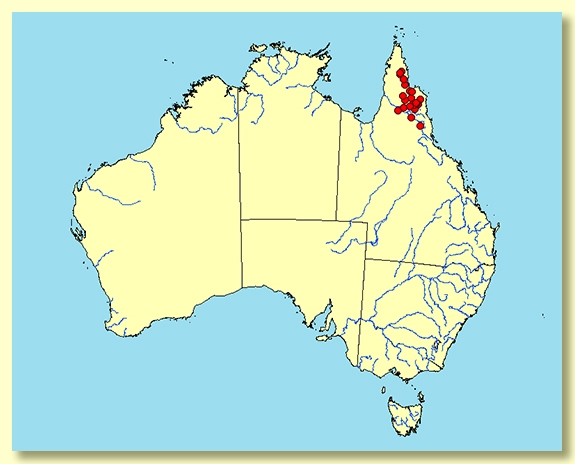Eucalyptus | Eudesmia | Complanatae
Euclid - Online edition
Eucalyptus megasepala
Tree 10 to 20 m tall. Forming a lignotuber.
Bark rough to the small branches, grey over grey-brown, finely stringy or fibrous, sometimes quite hard, forming longitudinal furrows.
Branchlets have pith oil glands especially near nodes; not glaucous.
Juvenile growth (coppice or field seedlings to 50 cm): stems squared in cross-section, smooth, non-glaucous; leaves opposite, petiolate (petioles ca 1.5-3 cm long), lamina broadly lanceolate to falcate, 12-25 cm long, 2.5-7 cm wide, base tapering to petiole, apex blunt or acute, margin entire, dull, green, concolorous, glabrous.
Adult leaves opposite to sub-opposite, petioles 1–2.2 cm long; blade lanceolate or falcate (8)10.5-19.5(22) cm long, (1)1.5–3(3.5) cm wide, base tapering to petiole, concolorous, dull green, side-veins at more than 45° to the midrib, rarely acute, tertiary venation sparse to moderate, intramarginal vein present and close to the margin, oil glands mostly island.
Inflorescence axillary single, peduncles 0.9-3 cm long, usually flattened-angular, buds 3 per umbel, pedicellate, (pedicels 0.3–1(1.3) cm long). Mature buds ovoid, obovoid or pyriform (1–1.3 cm long, 0.5–0.8 cm wide), basally 2-ribbed/angled, not glaucous, outer perianth whorl of 4 persistent sepals 0.5–1.2(1.5) cm long, the sepals each with a prominent central rib, inner perianth whorl united to form a rounded operculum with 4 prominent ribs and usually a coarse umbo, stamens inflexed, anthers oblong, versatile, dorsifixed, dehiscing by longitudinal slits (non-confluent), style long, tapering apically to a small blunt stigma, locules usually 3, the ovules arranged in 4 distinct vertical rows on the placentae. Flowers white or creamy white.
Fruit clusters on down-turned, spreading or erect peduncles; fruit pedicellate (pedicels 0.3–1(1.3) cm long), cup-shaped to ± cylindrical and often square in cross-section, 1.3–2.3 cm long, 0.9–1.6 cm wide, the sepals persistent on the rim of the fruit as four teeth 4-9 mm long, disc vertically descending, valves 3, enclosed.
Seeds grey, flattened-ovoid, 2–4 mm long, surface smooth, faint ridges may be present, a partial marginal flange may also be present, hilum ventral.
Cultivated seedlings (measured at node 10): not grown yet.
Flowering has been recorded in April, May, June, July, August, September. Bean (2006) notes that on Cape York, Queensland, E. megasepala and its closest relative E. tetrodonta, have flowering times that scarcely overlap, with the latter flowering from July to October.
A medium-sized tree, of restricted distribution in far north-eastern
In the classification of Brooker (2000) the nore recently published Eucalyptus megasepala would belong to the taxonomically complex Eucalyptus subgenus Eudesmia which is characterised by having cotyledons reniform in shape and folded inside the seedcoat, seedling leaves with +/- emergent oil glands with < 4 cap cells and ornamented by uni- or multicellular hairs, buds with the calyx of free sepals (rather than united to form an outer operculum as in most eucalypts) and branchlets with glandular pith. Within subgenus Eudesmia, Eucalyptus megasepala (and E. tetrodonta, E. baileyana, E. miniata, E. gigantangion, E. chartaboma, E. phoenicea and E. ceracea) make up section Complanatae which share the following features: tree habit, rough bark, stamens borne in a continuous ring, buds in axillary umbels and tropical/subtropical distribution. E. megasepala and E. tetrodonta are distinguished from the others by tall forest tree habit, rough grey fibrous bark throughout, buds in threes, the prominent sepals on the buds and which remain evident on the fruit, white flowers and smooth flattened ovoid seed with ribs and marginal flange poorly developed.
Eucalyptus megasepala is distinguished from E. tetrodonta by the former having much longer sepals in bud (5-12(15) mm long compared with 1-3 mm long), prominently ribbed buds including the operculum, and fruit square in cross-section.
From the Greek mega-, large and sepalum, sepals, referring to the sepals of this species being larger than those of E. tetrodonta.

